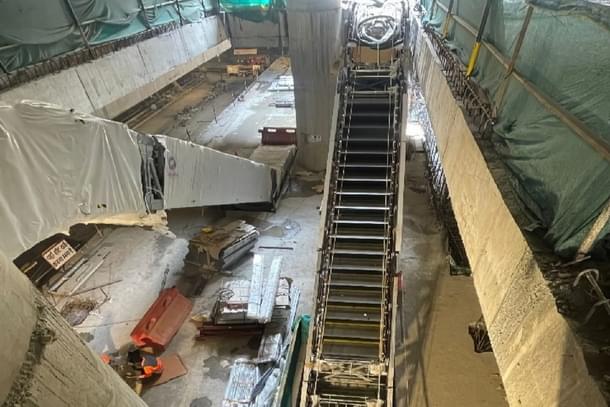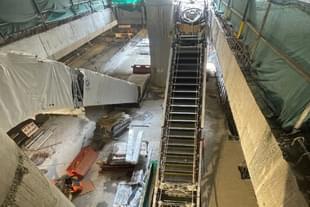Infrastructure
Meerut Metro: Underground Section Of Stations To Be Equipped With Modern Escalators
Arun Kumar Das
Sep 26, 2023, 10:07 AM | Updated 10:07 AM IST
Save & read from anywhere!
Bookmark stories for easy access on any device or the Swarajya app.


With the completion of the basic infrastructure of the Meerut metro station, the process of installation of escalators in the underground section of metro line has started from Bhainsali station.
Two escalators are being installed for the convenience of commuters between the concourse level and platform level of the station.
At present slab casting of the concourse level is completed and the slab casting of the platform level will also be completed soon. The process of installation of escalators in the other two underground stations of Meerut Metro — Begumpul and Meerut Central — will also start in a few days.
Escalators are electrically operated automatic stairs, which have now become an important part of modern transit infrastructures.
For the convenience of passengers, the escalators to be installed by NCRTC will be modern, with up-to-date technology, energy saving, and will be equipped with many new technologies for the safety and convenience of passengers.
The National Capital Region Transport Corporation (NCRTC) has signed a contract with Schindler India Private Limited, for the manufacturing of escalators for the entire corridor. Schindler India is manufacturing the escalators in Pune, Maharashtra.
Some important features of the escalators:
Use of skirt guards to reduce the possibility of loose clothing, such as sarees, getting entangled between the side panels of the escalator and the steps.
To protect the fingers of passengers while traveling on the escalator, finger guards will be installed on the handrails of the escalator.
There shall be a number of automatic safety devices to protect passengers from falling off the escalator upon abnormal operation of the escalator, including anti-reversal device, drive chain broken device, handrail broken device, escalator over speed device, step sag/step broken device, step Up-thrust device, step missing device, handrail monitoring device, etc.
Escalators will have the “V” type handrails for stronger grip.
Each escalator will have four flat steps with yellow line and yellow light for easy boarding and deboarding.
The sides of the escalator installed in the paid area inside the station will be made of glass, whereas in the non-paid area, it will be made of stainless steel.
For the safety of passengers on the escalator, there will be additional emergency stop switches at the top and bottom of the escalator, which can be used to stop the escalator if needed.
Bhainsali Metro station is approximately 260 metres long, but the platform length for passenger use will be 75 metres, while the rest of the station consists of technical rooms required for the station's operations.
These include the auxiliary sub-station, station control room, electrical control room, telecom equipment room, signaling equipment room that are being built and the remaining areas ahead of these rooms will be used for cross-overs for changing of tracks by trains.
There are twin parallel tunnels on both sides of the station. Along with the metro track, designated up and down tracks will also be built for RRTS trains the at Bhainsali metro station.
For the operations of the trains, cross-overs will be built between the tunnel and the platform for Metro and RRTS trains. The width of Bhainsali metro station is about 30 metres and the depth is about 17 metres.
Along with the completion work of the concourse and platform level of the station, finishing work has also started in the station.
On the other side air-duct installation for air conditioning, and construction work of the Overhead Traction Exhaust duct is being done.
For passengers' convenience dedicated washroom construction work is also in progress. Track laying and OHE installation activities will also be started soon at the station.
Apart from security check kiosks and ticket counters, Automatic Fare Collection (AFC) gates will be installed for passengers at the concourse level of the station.
AFC gates will be installed at the entry area of the station and passengers will be able to enter the station by scanning their travel card or ticket at the gates.
Along with this, there will also be other passenger-centric facilities like modern information display boards (including audio-video), system map showing important places around the station, CCTV cameras, fire extinguishing system etc.
This station has two (up-down) escalators from concourse level to platform level and four escalators from ground to concourse level (two escalators at UPSRTC Bus Stand entry-exit and two escalators at tehsil side entry-exit).
The entry-exit gates will be directly connected to the concourse level, and apart from this, two escalators will be installed at the entry-exit gate being built towards the Shaheed smarak.
This gate will be connected to the station through an underground walkway. A total of eight escalators will be installed in the station, out of which two have been installed.
Along with this, one lift will be installed at each entry-exit gate in the station from ground level to concourse level and two lifts will be installed between concourse level and platform level. The process of installing the lift has also started.
For the convenience of passengers, three entry and exit gates are being constructed. The first entry-exit gate of this station is being built on the other side of the road in front of Bhainsali station, towards the taxi stand located near the Shaheed Smarak near the Railway Road.
For this entry-exit gate, an underground subway will also be made to connect with the station and, people will be able to use this subway to cross the road without entering the paid area.
The second entry-exit gate of Bhainsali station is being built on Delhi Road itself along with the tehsil. The passengers commuting to Tehsil from different areas of Meerut will be facilitated with this entry-exit gate as every day a large number of people reach Meerut Tehsil.
With the completion of this station, it will become very easy to reach the tehsil for the people of Meerut.
The third entry-exit gate of the station is being built at a distance of a few meters towards the present Bhainsali bus stand, with the help of which passengers will be able to reach the RRTS corridor without any hassle and could reach their destination in less time.
Dedicated pick-and-drop facilities will also be available for passengers coming by public/private vehicles at these three entry points.
It is noteworthy that NCRTC is taking the initiative to provide local metro facilities on the RRTS corridor itself, with 13 stations in the 23 km length. The target is to operationalise this entire corridor for the public by June 2025.





